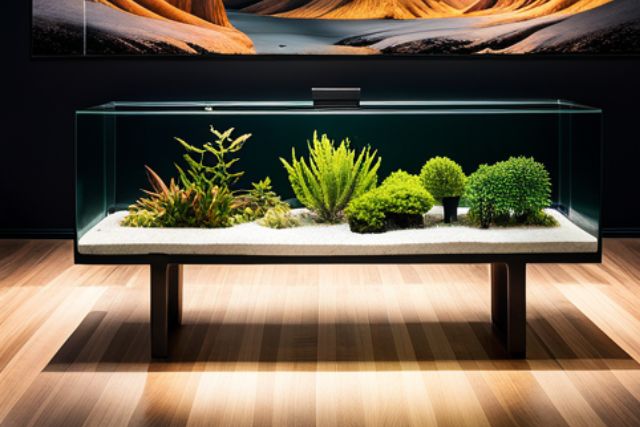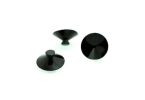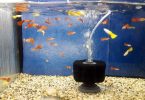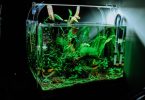Table of Contents
A 150-gallon fish tank is a popular choice among aquarium enthusiasts. It offers ample space for fish to swim around and provides enough room to include plants and decorations. However, before purchasing a 150-gallon fish tank, it is essential to know its dimensions to ensure it fits in the desired location and to properly plan for its setup.
The dimensions of a 150-gallon fish tank vary depending on the manufacturer, but typically it measures 72 inches in length, 18.5 inches in width, and 29.5 inches in height. When empty, the tank weighs around 281 pounds, and when filled with water, it can weigh up to 1800 pounds.
It is important to note that the weight of the tank increases significantly when filled with water, so it should be placed on a sturdy, level surface.
150 Gallon Fish Tank Dimensions
When it comes to keeping fish, having the right size tank is essential. A 150-gallon fish tank is a popular option for those who want to house a large number of small to medium-sized fish or invertebrates. Here are the dimensions of a 150-gallon fish tank:
Length
The length of a 150-gallon fish tank is 72 inches. This means that it is 6 feet long, making it a great option for those who want to house a large number of fish or invertebrates that require plenty of swimming space.
Width
The width of a 150-gallon fish tank is 18.5 inches. This means that it is just over 1.5 feet wide, making it a great option for those who want a tank that is not too wide but still provides plenty of swimming space for their fish.
Height
The height of a 150-gallon fish tank is 29.5 inches. This means that it is just over 2 feet tall, making it a great option for those who want a tank that is not too tall but still provides plenty of water volume for their fish.
Overall, a 150-gallon fish tank is a great option for those who want to house a large number of fish or invertebrates. With its dimensions of 72 inches in length, 18.5 inches in width, and 29.5 inches in height, it provides plenty of swimming space and water volume for your aquatic pets.
Tank Size and Weight
A 150-gallon fish tank is a large aquarium that provides ample space for fish to swim around and offers room to include plants and decorations.
The dimensions of a standard 150-gallon tank are 72 inches in length, 18.5 inches in width, and 29.5 inches in height.
Weight
When empty, a 150-gallon fish tank weighs around 281 pounds. However, when it is filled with water, the weight increases significantly, up to 1800 pounds.
Therefore, it is essential to ensure that the floor or stand where the tank is placed is strong enough to support the weight of the tank when it is full.
Water Volume
The water volume of a 150-gallon fish tank is 150 US gallons or 568 liters. This tank size is suitable for large fish species such as cichlids, angelfish, and discus, as well as smaller fish species that require plenty of swimming space.
It is important to note that the water volume of a fish tank affects the water parameters, such as pH, temperature, and ammonia levels.
Therefore, it is crucial to maintain the appropriate water quality and perform regular water changes to keep the fish healthy.
In summary, a 150-gallon fish tank is a large aquarium that provides ample space for fish to swim around and offers room to include plants and decorations.
It is essential to ensure that the floor or stand where the tank is placed is strong enough to support the weight of the tank when it is full.
Additionally, maintaining the appropriate water quality and performing regular water changes are crucial for the health of the fish.
Filtration System
When it comes to a 150-gallon fish tank, a proper filtration system is crucial for maintaining a healthy environment for fish and other aquatic life.
There are different types of filtration systems available in the market, but the most popular one is the sump filtration system.
Filtration
Filtration is the process of removing waste and debris from the water in the aquarium. A good filtration system should be able to remove all types of waste, including uneaten food, fish waste, and debris.
Sump Filtration System
A sump filtration system is a type of filtration system that uses a separate tank, known as a sump, to filter and process the water from the main tank.
The sump is usually placed below the main tank and contains different types of filtration media, such as mechanical, biological, and chemical filters.
The sump filtration system is an efficient way of filtering water as it provides a larger filtration area and allows for customization of the filtration process. It also helps to maintain a consistent water level in the main tank.
Flow
Flow refers to the movement of water in the aquarium. A good filtration system should provide adequate flow to ensure that all the water in the tank is filtered properly. Insufficient flow can lead to dead spots, where waste and debris accumulate, leading to poor water quality.
Circulation
Circulation refers to the movement of water in the aquarium, including the flow of water from the filtration system.
Proper circulation ensures that all areas of the tank receive adequate oxygen and nutrients, promoting the health of aquatic life.
In conclusion, a proper filtration system is crucial for maintaining a healthy environment in a 150-gallon fish tank.
A sump filtration system is an efficient and customizable way of filtering water, providing adequate flow and circulation for the well-being of aquatic life.
Heater and Lighting
Heater
When setting up a 150-gallon fish tank, it is important to choose the right heater to maintain the proper water temperature for your aquatic pets.
The size of the heater you will need depends on the volume of water in your tank, the average temperature of the room where the tank is located, and the desired water temperature for the tank.
As a general rule of thumb, it is recommended to use between 2.5 and 5 watts of heating power per gallon of water in the tank.
For a 150-gallon tank, this means a heater with a power output of at least 375 to 750 watts is needed. It is also important to choose a heater with a thermostat to ensure the water temperature remains stable.
LED Lighting
LED lighting is an excellent choice for aquariums as it provides a bright, energy-efficient light source that enhances the colors of your fish and plants.
When selecting LED lighting for a 150-gallon tank, it is important to choose a light fixture that is appropriately sized for the tank and provides the right spectrum of light for your aquatic plants.
A good rule of thumb for LED lighting is to provide 1 to 2 watts per gallon of water in the tank. For a 150-gallon tank, this means a light fixture with a power output of 150 to 300 watts is needed. It is also important to choose a light fixture with a timer to ensure a consistent photoperiod for your plants.
In addition to providing the right amount of light, it is important to choose an LED light fixture with a color spectrum that is appropriate for your aquatic plants.
Look for fixtures that provide a range of colors, including red and blue, to ensure your plants receive the full spectrum of light they need to thrive.
Overall, choosing the right heater and LED lighting for your 150-gallon fish tank is essential to creating a healthy and vibrant environment for your aquatic pets.
By selecting the appropriate equipment, you can ensure your fish and plants thrive and create a stunning display for your home or office.
Aquarium Stand and Cabinet
When setting up a 150-gallon fish tank, it is important to have a sturdy and reliable stand and cabinet to support the weight of the tank and its contents.
Here is some information about the stand and cabinet options available for a 150-gallon fish tank.
Stand
A stand is an essential component of any aquarium setup. It provides a stable base for the tank, ensuring that it is level and secure.
When choosing a stand for a 150-gallon fish tank, it is important to select one that is designed to support the weight of the tank and its contents.
There are a variety of stands available for a 150-gallon fish tank, including metal stands, wooden stands, and custom-built stands.
Metal stands are typically the most affordable option, but they may not be as aesthetically pleasing as wooden or custom-built stands.
Wooden stands are a popular choice because they are sturdy and attractive, and they can be customized to match the decor of the room.
Custom-built stands are the most expensive option, but they offer the most flexibility in terms of design and functionality.
Cabinet
In addition to a stand, many aquarium owners choose to purchase a cabinet to store their aquarium supplies and accessories.
A cabinet can help keep the area around the aquarium clean and organized, and it can also provide additional support for the tank.
Like stands, cabinets come in a variety of materials and styles. Wooden cabinets are a popular choice because they are sturdy and attractive, and they can be customized to match the decor of the room. Metal cabinets are also available, but they may not be as aesthetically pleasing as wooden cabinets.
Custom-built cabinets are the most expensive option, but they offer the most flexibility in terms of design and functionality.
Lifetime Warranty
When purchasing a stand or cabinet for a 150-gallon fish tank, it is important to consider the warranty offered by the manufacturer.
A lifetime warranty is ideal, as it ensures that the stand or cabinet will be replaced or repaired if it fails due to a defect in materials or workmanship.
Many manufacturers offer lifetime warranties on their stands and cabinets, but it is important to read the fine print to ensure that the warranty covers all potential issues.
Some warranties may only cover defects in materials, while others may also cover damage caused by normal wear and tear.
Overall, selecting a sturdy and reliable stand and cabinet is essential when setting up a 150-gallon fish tank. By choosing a high-quality stand and cabinet with a lifetime warranty, aquarium owners can ensure that their tank is stable, secure, and well-supported.
Fish and Plants
Fish
A 150-gallon fish tank provides ample space for a variety of fish species. When choosing fish for a tank of this size, it is important to consider the compatibility of the species, as well as their size and behavior. Some popular fish for a 150-gallon tank include:
Saltwater Fish
- Tangs
- Angelfish
- Clownfish
- Gobies
- Wrasses
Freshwater Fish
- Discus
- Angelfish
- Rainbowfish
- Cichlids
- Tetras
When selecting fish for a tank, it is important to research their specific needs and requirements, including water temperature, pH levels, and diet. It is also important to avoid overstocking the tank, as this can lead to poor water quality and health problems for the fish.
Plants
In addition to fish, a 150-gallon tank can also accommodate a variety of aquatic plants. These plants not only add visual interest to the tank, but also provide important benefits for the fish, such as oxygenation and natural filtration.
Some popular plants for a 150-gallon tank include:
- Amazon Sword
- Java Fern
- Anubias
- Water Wisteria
- Cryptocoryne
When selecting plants for a tank, it is important to consider their lighting and nutrient requirements, as well as their compatibility with the fish species in the tank.
It is also important to maintain proper water parameters, such as pH and nutrient levels, to ensure the health and growth of the plants.
Overall, a 150-gallon fish tank provides ample space for a variety of fish and plant species, allowing for a diverse and visually appealing aquatic ecosystem.
Decorations and Substrate
Decorating a 150-gallon fish tank can be a fun and creative process, but it’s important to keep in mind the impact that decorations and substrate can have on the overall health of the tank’s inhabitants.
Decorations
When selecting decorations for a 150-gallon fish tank, it’s important to consider the size and weight of the objects.
Large, heavy decorations can be difficult to move or clean, and can also pose a risk to the fish if they were to fall or shift. Some popular decoration options for a 150-gallon tank include:
- Driftwood
- Rocks and boulders
- Artificial plants
- Ceramic or resin statues
- Caves and tunnels
It’s important to avoid decorations that could potentially harm the fish, such as sharp or rough objects. Additionally, decorations should be cleaned regularly to prevent the buildup of harmful bacteria.
Substrate
The substrate, or material on the bottom of the tank, can also have an impact on the tank’s inhabitants. Some options for substrate in a 150-gallon fish tank include:
- Gravel
- Sand
- Crushed coral
- Aquatic soil
The substrate should be chosen based on the specific needs of the fish and plants in the tank. For example, some fish prefer a sandy substrate to sift through, while others prefer a rocky substrate to hide in. Additionally, certain plants may require a specific type of substrate to thrive.
It’s important to clean the substrate regularly to prevent the buildup of harmful bacteria and debris. This can be done by using a siphon to vacuum the substrate during regular water changes.
Overall, selecting the right decorations and substrate for a 150-gallon fish tank can enhance the tank’s aesthetic appeal while also promoting the health and well-being of its inhabitants.
Other Tank Sizes
When it comes to fish tanks, there are a variety of sizes available on the market. While a 150-gallon fish tank may be suitable for some enthusiasts, others may prefer a smaller or larger tank. Here are some other common tank sizes and their dimensions:
5 Gallon
A 5-gallon tank is a small aquarium that is suitable for a single betta fish or a few small freshwater fish. Its dimensions are 16 inches in length, 8 inches in width, and 10 inches in height.
2.5 Gallon
A 2.5-gallon tank is even smaller than a 5-gallon tank and is only suitable for a single betta fish or a few small freshwater fish. Its dimensions are 12 inches in length, 6 inches in width, and 8 inches in height.
10 Gallon
A 10-gallon tank is a popular choice for beginners and is suitable for a variety of fish, including tetras, guppies, and small cichlids. Its dimensions are 20 inches in length, 10 inches in width, and 12 inches in height.
15 Gallon
A 15-gallon tank is slightly larger than a 10-gallon tank and is suitable for slightly larger fish, such as angelfish or small schooling fish. Its dimensions are 24 inches in length, 12 inches in width, and 12 inches in height.
29 Gallon
A 29-gallon tank is a medium-sized aquarium that is suitable for a variety of fish, including larger tetras, cichlids, and angelfish. Its dimensions are 30 inches in length, 12 inches in width, and 18 inches in height.
30 Gallon
A 30-gallon tank is another medium-sized aquarium that is suitable for a variety of fish, including larger tetras, cichlids, and angelfish. Its dimensions are 36 inches in length, 12 inches in width, and 16 inches in height.
55 Gallon
A 55-gallon tank is a large aquarium that is suitable for a variety of fish, including larger cichlids, angelfish, and even some small saltwater fish. Its dimensions are 48 inches in length, 13 inches in width, and 21 inches in height.
75 Gallon
A 75-gallon tank is even larger than a 55-gallon tank and is suitable for a variety of fish, including larger cichlids, angelfish, and some medium-sized saltwater fish. Its dimensions are 48 inches in length, 18 inches in width, and 21 inches in height.
90 Gallon
A 90-gallon tank is a very large aquarium that is suitable for a variety of fish, including larger cichlids, angelfish, and some medium-sized saltwater fish. Its dimensions are 48 inches in length, 18 inches in width, and 24 inches in height.
125 Gallon
A 125-gallon tank is an extra-large aquarium that is suitable for a variety of fish, including larger cichlids, angelfish, and some large saltwater fish. Its dimensions are 72 inches in length, 18 inches in width, and 21 inches in height.
180 Gallon
A 180-gallon tank is a very large aquarium that is suitable for a variety of fish, including large cichlids, angelfish, and some large saltwater fish. Its dimensions are 72 inches in length, 24 inches in width, and 25 inches in height.
210 Gallon
A 210-gallon tank is an extra-large aquarium that is suitable for a variety of fish, including large cichlids, angelfish, and some large saltwater fish. Its dimensions are 72 inches in length, 24 inches in width, and 29 inches in height.
225 Gallon
A 225-gallon tank is a massive aquarium that is suitable for a variety of fish, including large cichlids, angelfish, and some large saltwater fish. Its dimensions are 72 inches in length, 30 inches in width, and 27 inches in height.
In conclusion, there are a variety of tank sizes available for fish-keeping enthusiasts. It is important to choose a tank size that is appropriate for the number and size of fish you want to keep.
Conclusion
In conclusion, a 150-gallon fish tank is a large aquarium that provides ample space for a variety of fish and other aquatic creatures.
The standard dimensions of a 150-gallon fish tank are 72 inches in length, 18.5 inches in width, and 29.5 inches in height. However, there are variations in dimensions and weight depending on the specific model and type of tank.
When setting up a 150-gallon fish tank, it is important to consider whether it will be a freshwater or saltwater tank, as this will affect the type of equipment needed.
For a saltwater tank, a center overflow is often necessary to ensure proper filtration and water flow. An air pump may also be necessary to provide adequate oxygenation for the fish and other creatures.
It is important to select equipment based on the size and dimensions of the tank to ensure its long-term success. This includes selecting a suitable stand that can support the weight of the tank when filled with water and gravel.
It is also important to consider the type of fish and other creatures that will be housed in the tank, as this will affect the type of filtration and other equipment needed.
Overall, a 150-gallon fish tank is a great option for fish-keeping enthusiasts who want to house a large number of small to medium-sized fish or invertebrates.
With proper setup and maintenance, it can provide a beautiful and thriving reef or freshwater ecosystem for years to come.







